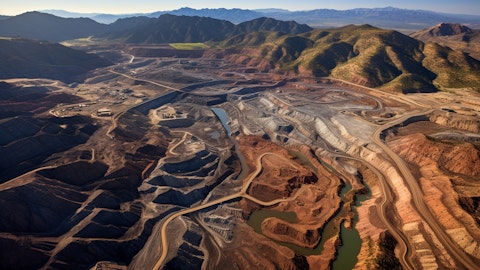Royal Gold, Inc. (NASDAQ:RGLD) Q4 2023 Earnings Call Transcript February 15, 2024
Royal Gold, Inc. isn’t one of the 30 most popular stocks among hedge funds at the end of the third quarter (see the details here).
Operator: Hello, everyone, and welcome to the Royal Gold, Inc. 2023 Full Year and Fourth Quarter Conference Call. My name is Emily, and I’ll be facilitating your call today. After the presentation, there will be the opportunity for any questions. [Operator Instructions] I will now turn the call over to our host, Alistair Baker, Vice President of Investor Relations and Business Development. Please go ahead, Alistair.
Alistair Baker: Thank you, operator. Good morning, and welcome to our discussion of Royal Gold’s fourth quarter and full year 2023 results. This event is being webcast live, and you will be able to access a replay of this call on our website. Speaking on the call today are Bill Heissenbuttel, President and CEO; Martin Raffield, Vice President of Operations; and Paul Libner, CFO and Treasurer. Randy Shefman, General Counsel; and Dan Breeze, Vice President, Corporate Development of RG AG are also available for questions. During today’s call, we will make forward-looking statements, including statements about our projections and expectations for the future. These statements are subject to risks and uncertainties that could cause actual results to differ materially from these statements.
These risks and uncertainties are discussed in yesterday’s press release and our filings with the SEC. We will also refer to certain non-GAAP financial measures, including adjusted net income, adjusted net income per share, cash G&A, adjusted EBITDA and net debt. Reconciliations of these measures to the most directly comparable GAAP measures are available in yesterday’s press release, which can be found on our website. Bill will start with an overview of 2023 results, Martin will give some commentary on the portfolio, and Paul will wrap up with a financial summary of the quarter. After the formal remarks, we’ll open the lines for a Q&A session.
Bill Heissenbuttel: Good morning, and thank you for joining the call. I’ll begin on slide 4. During 2023, we delivered revenue of $606 million, operating cash flow of $416 million and earnings of $239 million or $3.63 per share and after adjustments earnings were $3.53 per share. Our gold equivalent ounces or GEOs were slightly below our guidance range, as we indicated might occur during our third quarter conference call. And Martin will give you some more details a bit later. While inflation pressures have eased from their peak, operating companies are still seeing cost inflation and margin erosion. Without direct exposure to operating and capital costs, we are protected from inflation pressure and margin compression, and we maintained our strong adjusted EBITDA margin of 79%.
We paid approximately $100 million in dividends and keeping with our commitment to return capital to shareholders, and we raised our dividend again by 7%. This is the 23rd consecutive annual increase to our dividend, which is an unmatched record in the precious metals sector. We also maintained our focus on the balance sheet and repaid $325 million outstanding on a revolving credit facility during the year. After an active year of acquisitions in 2022, we started the year with a revolver balance of $575 million. And we’ve quickly reduced that to $250 million, increasing our total available liquidity at the end of the year to about $845 million. This is in keeping with our capital allocation strategy to use non-dilutive financing to acquire high-quality assets.
And we maintained our low share count during the year to ensure that shareholders have full exposure to our growth. Finally, we announced an agreement yesterday with Centerra to provide future cost support to the Mount Milligan mine that will allow an extension of the mine life to 2035 and potentially further into the future. The details are in our press release, but in summary, we will receive cash and gold consideration in the near and medium-term with a value of approximately $125 million at the current gold price and a longer-term free cash flow interest in Mount Milligan. In return, we’ll make additional cash payments for gold and copper delivered, with any support provided prior to approximately 2030, contingent upon gold and copper prices being below $1,600 per ounce and $3.50 per pound, respectively.
These earlier payments are also subject to potential recovery against cost support payments made beyond 2030, when metal prices permit. This is a good development for both Royal Gold and Centerra, as it should allow for further value to be realized through mine life extension. Mount Milligan has a large resource base and exploration potential, and Centerra’s plans include: completing a preliminary economic assessment in the first half of 2025 to evaluate resources and projects that could provide further mine life extensions; continuing exploration drilling around the mine; and completing a site optimization program to improve cash flow. Royal Gold will benefit from getting further exposure to metal prices over an extended mine life, and we are pleased to provide support to Centerra, as they review this potential.
I’ll now turn the call over to Martin to provide some comments on the portfolio.
Martin Raffield: Thanks, Bill. Turning to Slide 5, I’ll cover portfolio performance over the year compared to the guidance that we gave in April 2023. Overall, the portfolio performance was solid for the year. However, as Bill mentioned, total sales of 315,600 GEOs with slightly below our 2023 guidance of 320,000 to 345,000 GEOs. This was due to underperformance at two of our principal properties, both of which we have discussed on our last earnings call. The first was Peñasquito, where there was an unexpected four-month labor strike, and the second was the slower-than-anticipated ramp-up of the plant expansion of Pueblo Viejo. Our DD&A and tax rates were in line with guidance, and Paul will go into more detail on these items in his comments.
Turning to Slide 6, I’ll give some comments on fourth quarter revenue. Overall revenue for the quarter was $153 million with volume of 77,500 GEOs. Our Royalty segment contributed revenue of $54 million, in line with the prior year quarter. However, as a percentage of total revenue, the Royalty segment was a larger contributor than in the recent past at about 36% of total revenue. Revenue from our Stream segment was lower compared to last year at $98 million. Lower contributions from Mount Milligan and Pueblo Viejo were only partially offset by higher revenue from Andacollo, Xavantina and Rainy River. I’ll turn to Slide 7 and give some comments on notable developments at a handful of operations. At Mount Milligan, as Bill mentioned, Centerra reported an increase to the mine life to 2035, with the potential for work underway to increase this further.
Centerra also provided 2024 production guidance of 180,000 to 200,000 ounces of gold and 55 million to 65 million pounds of copper. Centerra expects this production to be evenly weighted throughout the year. At Pueblo Viejo, reported yesterday that construction and commissioning of the plant expansion was substantially complete at the end of December, and they have resolved the equipment issues they were dealing with in the second half of the year. They are working on rebuilding the crush or stockpile feed conveyor and are targeting completion of this work in the second quarter, which is required for the plant to reach full throughput. Our stream is based on Barrick’s share of production at PV, and Barrick is guiding to gold production of 420,000 to 490,000 ounces in 2024.
Approximately 165,000 ounces of silver were deferred during the quarter, and the total deferred amount was 854,000 ounces at the end of December. In yesterday’s report, Barrick commented that the focus for the first quarter will be the continued stability and optimization of the flotation circuit, which we expect should result in higher and more consistent silver recovery. This optimization work will likely take some time, and the recovery of our deferred silver ounces will depend on the outcome of this work. At Cortez, Barrick announced in mid-December that the record of decision was received for Goldrush, and they expect to ramp up production from 130,000 ounces this year to about 400,000 ounces per year in 2028. They also announced 2024 guidance for Cortez yesterday of 620,000 to 680,000 ounces, which includes the contribution from Goldrush.

This guidance is significantly lower than the 2023 production at Cortez, and according to Barrick as it relates to grade reconciliation and resource model changes at crossroads that will reduce oxide mill feed. Our overlapping royalty interest at crossroads result in an effective gross royalty rate of approximately 9.4%, so the impact of lower production at Crossroads has a disproportionately larger impact on Royal Gold. We are reviewing Barrick’s forecast and will detail the impact to Royal Gold when we issue our full year guidance. Turning to slide 8. At Andacollo, tech has reported that drought conditions are impacting production levels, and this is expected to continue while a solution is put in place in 2025. In the meantime, we’re expecting production levels this year to remain in line with 2023 and then increase in 2025 through 2027 with the benefit of higher grades.
At Khoemacau, operations are continuing at full production levels. Khoemacau is a high-quality operation, and we are pleased that M&G, a well-capitalized and experienced operator, will become the new owner after completing the acquisition, which is expected during the current quarter. We have spoken with MMG, and at this point, we don’t expect any significant changes to the operating approach put in place by KCM. And finally, we are pleased to see continued progress towards full production at King of the Hills and Bellevue mines in Western Australia. We expect to see first production from Cote Gold in Ontario and Mara Rosin in Brazil in the current quarter and Mancho in Alaska in the second half of the year. I’ll now turn the call over to Paul for a review of our financial results.
Paul Libner: Thanks, Martin. I’ll now turn to slide 9 and give an overview of the financial results for the quarter. For this discussion, I’ll be comparing the quarter ended December 31, 2023, to the prior year quarter. Revenue was down 6% to $153 million for the quarter. As Martin mentioned in his remarks, lower contributions from Mount Milligan, Pueblo Viejo, and Peñasquito were the main drivers for this quarter’s lower revenue. The lower contribution from these properties were partially offset by higher contributions from Cortez and Andacollo as well as higher average metal prices. Gold and silver prices were significantly higher, up 14% and 10%, respectively, and the price of copper was up 2%. Gold continues to be the dominant revenue source, making up 80% of our total revenue for the quarter, followed by silver at 10% and copper at 8%.
At 80%, Royal Gold has the highest gold revenue percentage compared to our major peers in the royalty and streaming sector. Turning to slide 10, I’ll provide a bit more detail on specific line items for the quarter, which was another straightforward and quiet quarter for Royal Gold. G&A expense increased slightly to $9.7 million from $8.8 million in the prior year and was due to higher corporate costs and non-cash stock compensation expense. Although, we did see an increase over the prior year, our cash G&A costs remained low at about 5% of total revenue. Our DD&A expense decreased to $40 million from $49 million in the prior year. On a unit basis, this expense was $518 per GEO for the quarter compared to $521 per GEO in the prior year. The lower overall DD&A expense was due to a lower depletion rate at Pueblo Viejo, as well as decreased sales from Mount Milligan and Pueblo Viejo when compared to the prior year.
For the full year, DD&A of $529 per GEO was in line with our earlier guidance range of $490 to $540 per GEO. Interest expense was $6 million for the quarter, in line with $6.1 million in the prior year. The all-in interest rate for outstanding borrowings under our credit facility was 6.6% at the end of the fourth quarter. Tax expense for the quarter was $13.4 million, resulting in an effective tax rate of 17.5%. This compares to a similar tax expense of $12.6 million and an effective tax rate of 18.2% in the prior year. For the full year, tax expense was $42 million and the effective tax rate was 14.9%. Our full year tax expense and effective tax rate benefited from a previously disclosed discrete tax event during the June quarter and related to the release of a valuation allowance on certain foreign deferred tax assets.
Excluding this discrete item, the effective tax rate for the full year was 17.9%, which was in line with our guidance rate of 17% to 22%. Net income for the quarter was up 11% over the prior year to $63 million or $0.95 per share. The increase in net income was primarily attributable to the lower cost of sales and DD&A expense, along with the $4 million impairment we recognized in the prior year on a non-principal exploration stage royalty interest. Each of these were partially offset by a decrease in our revenue as I previously mentioned. Our operating cash flow was strong again this quarter at $101 million and in line with the prior year. We expect to provide full year guidance for 2024 early in the second quarter after most of our counterparties have issued their own production guidance for the year.
However, to help you prepare your March quarter estimates, we expect our Stream segment sales to range between 47,000 and 52,000 GEOs during the first quarter of 2024. As with our prior practice, this is the only quarter during the year when we will give quarterly guidance, and this quarterly guidance should not be viewed as indicative of the full year guidance we intend to provide early in the second quarter. I will now turn to slide 11 and provide a summary of our financial position at the end of the quarter. During the quarter, we repaid $75 million on our revolving credit facility and reduced the amount drawn to $250 million. As Bill mentioned, our strong cash flow during 2023 allowed us to repay $325 million on our revolver balance during the year.
With respect to leverage ratios, we ended 2022 with a one-time net debt-to-EBITDA ratio. And by the end of 2023, this ratio was down to 0.3 times. This is a remarkable change in a short period and speaks to the cash flow generation of our portfolio and reinforces our overall capital allocation strategy, which also emphasizes a focus on the balance sheet. Absent significant business development activity and as cash flow allows, we expect to fully repay the remaining revolver balance by sometime early in the second half of 2024. We ended the year in a very strong financial position with total available liquidity of approximately $845 million, made up of $750 million of undrawn revolver capacity and $95 million of working capital. Finally, I’ll also mention that upon completion of the acquisition of Khoemacau by MMG, we expect repayment of the subordinated debt facility we provided to KCM as part of the overall development of the Khoemacau mine.
At the end of December, the total amount outstanding, including capitalized interest, was approximately $36 million. That concludes my comments on our financial performance for the quarter, and I will now turn the call back to Bill for closing comments.
Bill Heissenbuttel: Thanks, Paul. 2023 was another year of consistent and solid performance from Royal Gold. We maintained alignment with our strategic goals of keeping a disciplined focus on gold, strengthening our balance sheet and increasing our capital return. We had a very active year of adding assets to the portfolio in 2022. And during 2023, we took advantage of our strong cash flow to pay down the debt used to finance those transactions as well as continue our long record of increasing our dividend. Our balance sheet is in great shape, and we have excellent liquidity to compete and take advantage of business development opportunities that may present themselves. We expect to provide full year guidance for 2024 early in the second quarter, which will reflect the lower production at Cortez and smaller organic growth assets that we have previously discussed like King of the Hills, Bellevue, Côté, Mara Rosa, and Manh Choh.
We also expect to publish an asset handbook early in the second quarter, and we plan to host an in-person session to give a more fulsome update on the portfolio around the same time. Operator, that concludes our prepared remarks. I’ll now open the line for questions.
Operator: Thank you. [Operator Instructions] Our first question comes from Jackie Przybylowski with BMO Capital Markets. Jackie, please go ahead.
See also 13 Overlooked Tax Deductions for Retirees That Could Save Them Money and 20 Popular Brands That Use Shopify.
Q&A Session
Follow Royal Gold Inc (NASDAQ:RGLD)
Follow Royal Gold Inc (NASDAQ:RGLD)
Jackie Przybylowski : Yes. Thanks very much and thanks for taking my question. I know you addressed this a little bit in your prepared remarks, but if you could give us a little bit more color on what happened, I guess, on Nevada Gold Mines, that would be really helpful whatever you can maybe tell us about. I know they had sort of mentioned in their call yesterday that there were some issues with accessing grade. Can you maybe just give us a little bit more color on what’s happening there?
Bill Heissenbuttel : Hey, Jackie, thanks for the question. When you refer to Nevada Gold Mines, I assume you mean Cortez in particular?
Jackie Przybylowski : Sorry, yes. Yes, sorry. Cortez.
Bill Heissenbuttel : Yes. Okay. Yes, that’s fine. I’ll just turn this over to Martin to give you a little background. I’m not sure we know much more, but Martin, over to you.
Martin Raffield: Yes. Thanks, Jackie. We really don’t know much more than what was said on the call yesterday with Mark Bristow. They talked about a resource model change to the Crossroads area. They talked about that, indicating that it would reduce the oxide mill feed in 2024. And it was ascribed to a fault cutting off the high-grade ore in the pit that I think is a fairly recent point of understanding. So not really much more than that. In terms of how this impacts us, would you be interested in understanding more about that, Jackie?
Jackie Przybylowski : Yes, absolutely. Thank you.
Martin Raffield: So Cortez overall in 2023 had a really strong year. They produced about 890,000 ounces on a 100% basis. Out of that, we received about 49,000 GEOs. And about 80% of the 49,000 GEOs was sourced from our legacy zone with a high royalty rate of 9.4%. And that was really primarily driven in turn by the Crossroads production. So, 2024 guidance for Barrick is now 620,000 to 680,000 ounces again on a 100% basis and this represents about a decrease of 27% from their 2023 production actual numbers to the midpoint of that 2024 guidance. And really with — this impact to us is disproportionate because of our 9.4% gross royalty percentage over the Crossroads area and the impact to that Crossroads pit that they are now talking about.
Due to our revenue mix at Cortez, the overall decrease from our 2023 production GEOs of 49,000 is going to be in the region of 40% to 50%. Can’t really provide any more detail about what’s happening at Crossroads at the moment. We don’t know any more than the rest of the market, but we do hope to be able to provide some more detail on that when we get to our 2024 guidance.
Jackie Przybylowski: Okay, great. That was actually going to be my next question. When you put your guidance out in April, that will be reflected in your guidance, I guess, right, for 2024?
Martin Raffield: Absolutely, yes.
Jackie Przybylowski: Great. Okay. Thank you so much.
Bill Heissenbuttel: Thanks Jackie.
Operator: Our next question comes from Cosmos Chiu with CIBC. Please go ahead.
Cosmos Chiu: Hi. Thanks Bill, Paul, Martin, and Alistair. Maybe my first question is on your 2024 guidance as well. I know you haven’t put it out yet. I’m just trying to figure out the thought process through it and your process in terms of how you come around in terms of putting your guidance together, of course, there’s challenges like Crossroads and Cortez? And as you mentioned, 2024 will also benefit from start-ups or ramp-ups at Bellevue, King of the Hills and a number of new assets like Cote and Goldrush. And so how do you go about your process of putting guidance together? And how do you kind of factor in any kind of risk, any kind of ramp-up risk and start-up risk and things like that?
Bill Heissenbuttel: Yes, Cosmos, thanks for the question. I mean, the process is very much bottom-up. And Martin and his team, I think they meet numerous times to talk about individual assets. Now, it kind of depends on the asset itself and the contract because in some cases, we have excellent information rights. We may have a budget for the year. But in others, especially on the Royalty side and the solar Royalty side, we don’t really know. All we can go on is what the operators are saying publicly. Just as an example, Peñasquito is a royalty we don’t really have any information right. So, we wait to hear what Newmont says about what’s going to happen at Peñasquito. So, that’s probably why it takes us a little bit longer than others because we had to compile the guidance that is given by the operators.
I will tell you that we do make adjustments. It’s one of the reasons we don’t give guidance on an asset-by-asset basis because we may get a number from an operator or see a number from an operator in the public domain. And just say, well, based on our experience, what we’ve seen at that mine historically, they may not achieve that recovery rate and they may not achieve that grade that they expect. So that’s kind of the process, and that’s why it takes us another couple of months to put it together.
Cosmos Chiu: Yes. I guess asked more directly, would you say you’re fairly conservative when you put this together?
Bill Heissenbuttel: I mean, we’re — I don’t want to say we’re fairly concerned. We try to be fair based on what we expect. I don’t want anybody to think that we sort of take the numbers and be more conservative on guidance so that hopefully we can exceed guidance. That’s not how we do things. We put out a number that we think is achievable.
Cosmos Chiu: Understood, great. Maybe switching gears a little bit. Congratulations on getting additional deals or kind of like the agreement with Centerra completed. From that perspective, I had to read it quite a few times in your press release yesterday, your new agreement with Centerra. Fairly complex, a lot of moving parts. Can you maybe talk about how you came up with that structure, the different kind of production hurdles that you’ve put in? And would it have been easier to kind of rewrite the origin agreement? Because I know this agreement here is in addition to the original agreement. So maybe the thought process around that as well.
Bill Heissenbuttel: Yes. I mean, I will say I would agree with you. The first place you would think of going is to amend the existing agreement, I will say. Sometimes, amending agreements creates complications, and we just felt that in order to avoid some complications, it would be better to leave that agreement completely untouched. This is sort of a mine life extension project. This is a bolt-on agreement that supports that mine life extension. And that’s the direction that the negotiations sort of took over time. As for the specific numbers, I just wonder if I might ask Dan Breeze to sort of offer his thoughts. Dan was sort of our lead negotiator on the transaction and maybe he can share some thoughts with you.
Dan Breeze: Hi, Cosmos, thanks for the question.
Cosmos Chiu: Hi, Dan.
Dan Breeze: Maybe we could just talk a little bit about, I think if your question — if I understand your question, you’re asking about how we ended up with this structure generally speaking? Or do you want to actually get into the numbers?
Cosmos Chiu: No, I think generally speaking, how you came over the structure and how it is the best structure for the situation today?
Dan Breeze: Sure. Well, obviously, we had to consider our interest here and what we thought was appropriate and acceptable for our shareholders but also what Centerra was looking to do. And ultimately, we were aligned in that sense with looking for ways to ultimately extend the mine life. And that was really the key reason or driver of the structure, thinking about the long-term, thinking about a way where we could provide long-term cost support. And that, as you heard Centerra talked about this yesterday in their call that will allow them to make investments, if you will, today and going forward over the next one year, 1.5 years to hopefully realize what that longer-term plan will look like. So that was really the main driver, Cosmos.
And then looking at the shorter-term, between now and, say, 2030, what we tried to do there is consider Centerra’s focus on their reserve plan and the numbers that they were working towards and not wanting to impact our economics over that time period. And so that’s what we put in place, a structure that is unlikely to be drawn, just given the triggers of the commodity prices below $1,600 and $3.50 a pound in copper, so well below where we are with long-term consensus prices. But that structure just gives them the confidence to move forward on that reserve plan. So I think those are the two main factors that fit into or we consider to fit into this new well structure that you see.
Cosmos Chiu: Great. Thank you, Dan. That perfectly answers my question, and thanks, Bill, as well. Thank you.
Bill Heissenbuttel: Thanks, Cosmos.
Operator: [Operator Instructions] Our next question comes from Lawson Winder with Bank of America. Lawson, please go ahead.
Lawson Winder: Thank you very much, operator. And hello, gentlemen, good morning and good afternoon. I just had a couple of questions for you. So one was on the guidance for Q1. Thank you for providing that. It’s always helpful to have that in a full year guidance. How did you guys think about Andacollo for that in terms of production? I don’t know, if you can provide — or in terms of deliveries, I don’t know if you can provide a range, but is something kind of like 2024 divided by four kind of the right way to think about that? And then yes, that would be the first question on the guidance.
Bill Heissenbuttel: Hey, Lawson, so is your question on the quarterly guidance that we just gave because that number, we would pretty much know because Andacollo was one of those assets where we received the gold about five or six months after it’s been shipped. So we would have a pretty good idea of what that is.
Lawson Winder: That’s exactly what I’m asking. If you could tell us the number, that would be great.
Bill Heissenbuttel: We don’t do asset-by-asset guidance. And I don’t think we’ve ever given exactly what a particular asset is going to do in any quarter.
Lawson Winder: So yeah, so just thinking about Andacollo in particular, like accounting for the fact that they had those issues with water in Q4. And you’ve disclosed that in your 10-Q what the full year deliveries were. I guess, the question is then what was Q4 production, I guess, in terms of seasonality? Was Q4 much lower than Q1, Q2 and Q3 as a result of those or more in line? Just any sort of color on that direction would be helpful.
Bill Heissenbuttel: I don’t know. Martin, is there anything that you can think of that we could provide right now?
Martin Raffield: Look, Teck had talked, Lawson, about the issues going into next year with the drought conditions and how that is potentially going to impact them. I think we probably started to see some of those impacts towards the end of last year. But I don’t have — I don’t think numbers — individual numbers for the production we should be talking about at the moment.




